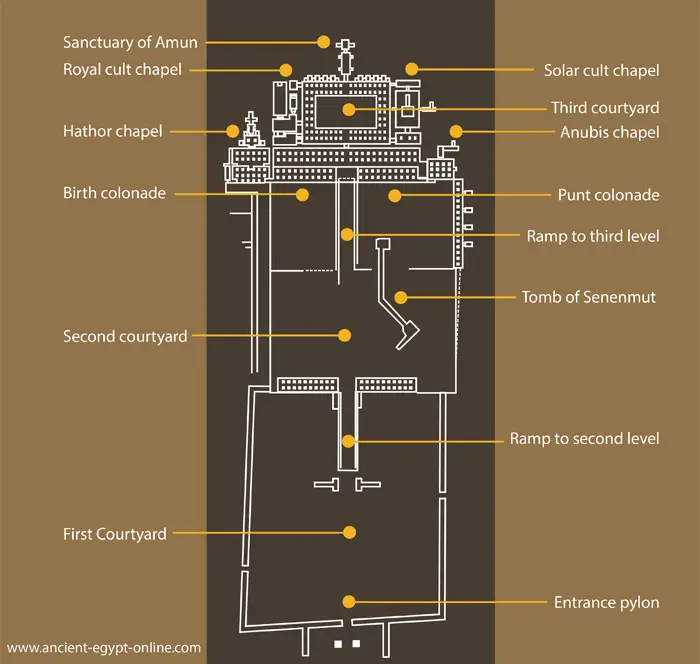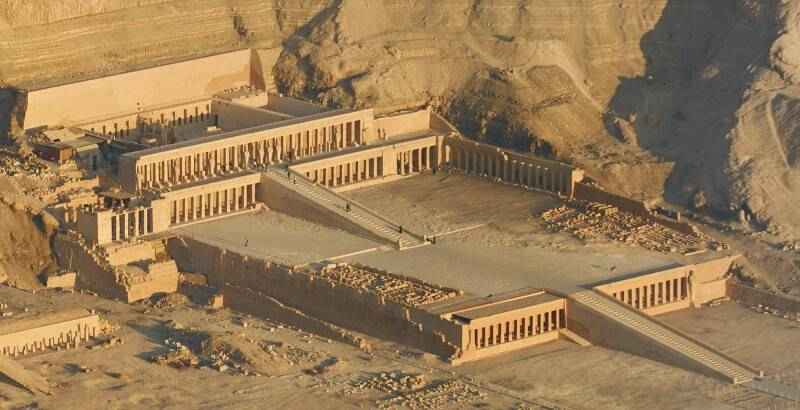Mortuary Temple of Hatshepsut
Welcome to the enchanting world of Queen Hatshepsut Temple, a remarkable testament to the power and influence of one of ancient Egypt's most celebrated pharaohs. Nestled within the rugged cliffs of Deir el-Bahari near Luxor, this temple complex offers a glimpse into the remarkable reign of Queen Hatshepsut and the architectural wonders she left behind. Join us as we explore the fascinating history, artistic splendor, and enduring legacy of this iconic monument.
The Life and Reign of Queen Hatshepsut: A Trailblazing Pharaoh
Queen Hatshepsut defied societal norms and expectations by ascending to the throne as Egypt's first female pharaoh. Known for her intelligence, political acumen, and keen understanding of the arts, she ruled during the New Kingdom era, around 1478 to 1458 BCE.
During her reign, Queen Hatshepsut embarked on ambitious building projects, promoting trade expeditions, and establishing Egypt's influence abroad. Her temple at Deir el-Bahari stands as a testament to her remarkable achievements and enduring legacy.
The Architecture and Design of Queen Hatshepsut Temple
Queen Hatshepsut Temple is renowned for its unique architectural design, blending harmoniously with the surrounding natural landscape:
Terraced Structure: The temple is built in a series of terraces, following the natural contours of the cliffside. This design creates a visually striking structure that appears to merge with the rocky backdrop.
Colonnaded Courtyards: As you ascend the terraces, you'll encounter magnificent colonnaded courtyards adorned with beautifully carved pillars. These columns are intricately decorated with scenes from Queen Hatshepsut's reign, depicting religious ceremonies, military conquests, and offerings to the gods.
The Sanctuary of Amun: At the heart of the temple complex lies the Sanctuary of Amun, the primary deity worshipped during Queen Hatshepsut's reign. Here, priests performed sacred rituals and offerings to ensure the prosperity and divine protection of Egypt.

Reliefs and Artwork: Capturing the Glory of Queen Hatshepsut
The walls of Queen Hatshepsut Temple are adorned with exquisite reliefs and artwork that provide valuable insights into the queen's life and accomplishments:
Birth and Coronation Scenes: The reliefs depict Queen Hatshepsut's divine birth and her coronation, showcasing her legitimacy as a pharaoh. These scenes often feature the god Amun-Ra and the goddess Hathor, emphasizing her divine connection.
Pictorial Narratives: The temple's reliefs also tell the story of Queen Hatshepsut's military campaigns and trade expeditions. They depict scenes of triumphant battles and the presentation of exotic goods brought back from distant lands.
Divine Iconography: The reliefs highlight Queen Hatshepsut's close association with the gods. She is often depicted in the traditional pharaoh's regalia, including the ceremonial beard and the double crown, symbolizing her authority and divine legitimacy.
Visiting Queen Hatshepsut Temple: A Journey Through Time
When visiting Queen Hatshepsut Temple, there are several key highlights and considerations:
Approach to the Temple: As you approach the temple complex, marvel at its impressive façade and the grandeur of the terraced structure. Take a moment to appreciate the blending of natural beauty with human ingenuity in its architectural design.
Temple Courtyards: Explore the colonnaded courtyards and marvel at the intricate carvings and hieroglyphics that adorn the pillars and walls. These elaborate scenes depict religious rituals, offerings to the gods, and the queen's achievements, offering a window into the religious and cultural practices of ancient Egypt.
Statues and Obelisks: Discover the impressive statues and obelisks that once stood proudly within the temple complex. Although many have been damaged or destroyed over time, their remnants still bear witness to the grandeur and power associated with Queen Hatshepsut's reign.
The Chapel of Hathor: One of the most significant areas within the temple is the Chapel of Hathor, the goddess of joy, love, and beauty. Admire the beautifully preserved reliefs that depict the queen in the presence of Hathor, underscoring her divine connection and seeking the blessings of the goddess.
Preservation and Restoration Efforts
Preserving the legacy of Queen Hatshepsut Temple is of utmost importance. The Egyptian Ministry of Antiquities, along with international organizations, invests in ongoing restoration and conservation projects to protect and restore the temple's architectural elements and artworks.
Visitors are urged to contribute to the preservation efforts by respecting the site's rules and regulations. It is crucial to refrain from touching or vandalizing the ancient structures and artifacts. By treating the temple with care and reverence, we can ensure its longevity for future generations.
Unraveling the Legacy of Queen Hatshepsut
Queen Hatshepsut Temple stands as a remarkable testament to the reign of one of Egypt's most influential pharaohs. It offers a unique glimpse into the achievements, religious practices, and artistic expression of the New Kingdom period.
Visiting this awe-inspiring temple allows us to connect with the past, to witness the triumphs and aspirations of an extraordinary female ruler who defied conventions and left an indelible mark on ancient Egypt's history.
As you explore Queen Hatshepsut Temple, take a moment to imagine the bustling activity that once filled its courtyards and halls. Envision the elaborate ceremonies, the prayers offered to the gods, and the vibrant life that once permeated this sacred space.
Let the beauty and grandeur of the temple transport you back in time, where the reign of Queen Hatshepsut unfolds before your eyes, revealing her remarkable legacy as a visionary leader, a revered pharaoh, and an icon of female empowerment in ancient Egypt.
Egypt Tours Including Queen Hatshepsut Temple
| Tour | Itinerary | Price |
|---|---|---|
| Sonesta Amirat Dahabiya | 8 Days | Inquire |
| Sonesta St George | 4-5 Days | Inquire |
| Sonesta Moon Goddess | 4-5 Days | Inquire |
| Jaz Crown Jubilee | 4-5 Days | $ 627 |
| Iberotel Crown Empress | 4-5 Days | $ 649 |
| Ms Salacia Nile Cruise | 4-5 Days | $ 709 |
| Minerva Nile Cruise | 4-5 Days | $ 709 |
| Movenpick Royal Lotus | 4-5 Days | $ 815 |
| Ms Esplanade Nile Cruise | 4-5 Days | $ 825 |
| Ms Mayfair Nile Cruise | 4-5 Days | $ 850 |
| Nile Goddess | 4-5 Days | $ 935 |
| Ms Tosca Nile Cruise | 4-5 Days | $ 975 |
| Wheelchair Accessible Nile Cruise | 4-5 Days | $ 1145 |
| Nuun and Nuut Dahabiya | 4 Days | $ 1157 |
| Ms Darakum Nile Cruise | 4-5 Days | $ 1250 |

